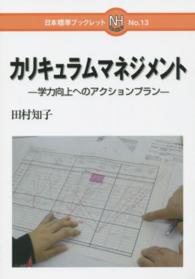- ホーム
- > 洋書
- > 英文書
- > Business / Economics
Full Description
There has been widespread dissatisfaction with accepted models for predicting the conditions that people will find thermally comfortable in buildings. These models require knowledge about clothing and activity, but can give little guidance on how to quantify them in any future situation. This has forced designers to make assumptions about people's future behaviour based on very little information and, as a result, encouraged static design indoor temperatures.
This book is the second in a three volume set covering all aspects of Adaptive Thermal Comfort. The first part narrates the development of the adaptive approach to thermal comfort from its early beginnings in the 1960s. It discusses recent work in the field and suggests ways in which it can be developed and modelled. Such models can be used to set dynamic, interactive standards for thermal comfort which will help overcome the problems inherited from the past. The second part of the volume engages with the practical and theoretical problems encountered in field studies and in their statistical analysis, providing guidance towards their resolution, so that valid conclusions may be drawn from such studies.
Contents
Part I: Foundations 1. Introduction to adaptive behaviour 2. Adaptive Beginnings 3. The emergence of the adaptive point of view 4. Summertime Overheating in Schools 5. The first international conference on thermal comfort 6. Adapting to enforced changes of temperature 7. The First Meta-analysis 8. Clothing outdoors and during sleep 9. Meta-analysis 2: relating climate to indoor comfort 10. The origin of the Oxford Thermal Comfort Unit 11. Fieldwork in Pakistan 12. Raising awareness of the adaptive approach 13. Beginning fieldwork at Oxford Brookes University 14. PMV and the results of field studies 15. Adaptation and the ASHRAE RP-884 database 16. Going international: the SCATs project Part II: Analysis 17. Introducing part 2 18. Using the Method of Successive Categories to explore the properties of thermal comfort scales 19. Developing, adapting and testing thermal subjective scales 20. A Simple Heat Exchange Model for Thermal Comfort Conditions 21. Regression analysis: general features and effects of data-selection and binning 22. The effects of error in the predictor-variable 23. Mutual relation between room temperature and subjective warmth 24. The relation between regression analysis and probit analysis 25. The dependence of subjective warmth on within-day changes in room temperature 26. Constructing Bell-shaped Curves for Comfort and Temperature 27. Tolerance of seasonal drift of indoor temperature 28. Estimating Neutral Temperatures from Survey Data 29. The adaptive relation between indoor neutral temperatures and the outdoor climate 30. Do people like to feel neutral? Semantic offsets and zero-errors 31. Clothing and thermal behaviour 32. Interactions among environmental variables, adaptation and overall comfort 33. Drawing the threads together








